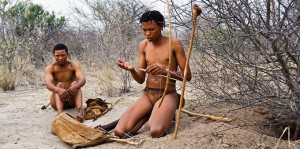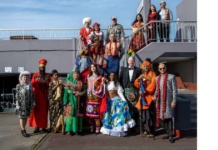As the original inhabitants of southern Africa, the San lived for millennia as independent hunters and gatherers. The rich heritage of rock art there is attributed to ancestral San. The San represent for many an unspoiled “natural humanity” living in harmony with nature, and the works of Laurens Van Der Post and films like The Gods Must Be Crazy reinforce this romantic image. The reality for present-day San is different. They are second-class citizens in the lands of their birth, and suffer daily discrimination at the hands of other ethnic groups. Not so long ago, Tswana tribespeople referred to their San servants as “bulls” and “heifers.” One Motswana, seeing a group of San children playing, said, “If only they went to school they would be people”
The San’s history is not unique. Virtually all southern African peoples have experienced wrenching cultural change, war, dispossession, and ethnocide. But the San’s plight was compounded by their status as social outcasts, not only in the eyes of European settlers, but by their fellow Africans as well. As described, surviving Sans were the subjects of special statutes in every country they lived in.
Their nomadic ways, essential to their survival, were treated as vagrancy and suppressed. In certain areas repression and violence continue to the present. It is a tribute to San resilience and cultural strength that they have overcome many obstacles to retain their language, culture, and religious beliefs, even if circumstances have forced them to give up foraging. Coming to political consciousness, some San have recreated themselves as First Peoples, and, with the assistance of sympathetic outsiders, have fought successfully for land and civil rights.
While discrimination remains, governments in the region have begun to recognize the San’s uniqueness and to institute at least some policies in support of San development aspirations. This special issue of the Cultural Survival Quarterly will pinpoint areas where serious injustices persist, but will also give examples of communities where small victories have been won in the fight for cultural survival. The San in History Ancestral San peoples have lived in southern Africa since ancient times.
The oldest unequivocal remains of Homo sapiens sapiens—dated to 125,000 B.C.E.—have been excavated at Klassies River Mouth east of Cape Town. For thousands of generations the San people lived, hunting and gathering, as the sole occupants of southern Africa. Archaeological evidence records that they lived in small mobile groups with a complex microlithic stone tool technology.
Around the time of Christ some of the San hunters began to herd goats and sheep and later cattle, becoming in time the Khoi peoples, also known as Hottentots. Both San and Khoi retained the unique click languages for which they are famous. In the early years of the Common Era, proto-Bantu-speaking peoples crossed the Zambezi and began their famous southward migration that led to the formation of the powerful Zulu, Xhosa, Tswana, and Sotho chiefdoms whose descendants form the large majority of South Africa’s population today.
In the East, San and incoming Bantu peoples mixed and intermarried and the latter adopted the click sounds of the Khoisan languages. In the western part of the subcontinent, however, San and Khoi retained their autonomy. They were at the Cape of Good Hope on that fateful day in 1652 when Jan Van Riebeck of the Dutch East India Company landed to establish the first European settlement in what is now South Africa. The ensuing centuries constitute one of the most tragic chapters in the history of European colonialism. As the Dutch expanded north, they conquered the Khoi tribes, who eventually assimilated and reemerged as the so-called Cape Coloured people. But because they resisted Dutch advances so successfully, the San were branded as incorrigible bandits and hunted down relentlessly by the Dutch (now naturalized as Boers or Afrikaners) in annual extermination raids.
By the end of the 19th century, San people were believed to be virtually extinct in South Africa. But beyond the reach of Boer guns, in the German colony of South-West Africa and in the British protectorate of Bechuanaland, San peoples survived and even thrived, and it is in contemporary Namibia and Botswana that most of today’s San live. Distance, and the isolation of the Kalahari Desert and its surrounding regions, proved to be the San’s salvation. Nearly 80,000 San are found there today, with smaller numbers in Angola, Zambia, and Zimbabwe. In the 20th century, a number of San groups continued to maintain the small-scale nomadic hunting and gathering way of life recorded by anthropologists and filmmakers.
A larger percentage, however, were drawn into oppressive work conditions and deeper poverty under the domination of both African and White powerholders. In a surprising development, the end of Apartheid brought to light in South Africa San peoples speaking languages long believed to be extinct. They had blended into the rural landscape on White farms or on the fringes of towns until the end of Apartheid allowed them to reveal their identities









